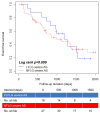Prediction of symptom development and aortic valve replacement in patients with low-gradient severe aortic stenosis
- PMID: 38529170
- PMCID: PMC10961946
- DOI: 10.1093/ehjopen/oeae018
Prediction of symptom development and aortic valve replacement in patients with low-gradient severe aortic stenosis
Abstract
Aims: Current evidence on the prognostic value of exercise stress echocardiography (ESE) in asymptomatic patients with low-gradient severe aortic stenosis (AS) is limited. Therefore, this study aimed to elucidate its prognostic implications for patients with low-gradient severe AS and determine the added value of ESE in risk stratification for this population.
Methods and results: This retrospective observational study included 122 consecutive asymptomatic patients with either moderate [mean pressure gradient (MPG) < 40 mmHg and aortic valve area (AVA) 1.0-1.5 cm2] or low-gradient severe (MPG < 40 mmHg and AVA < 1.0 cm2) AS and preserved left ventricular ejection fraction (≥50%) who underwent ESE. All patients were followed up for AS-related events. Of 143 patients, 21 who met any exclusion criteria, including early interventions, were excluded, and 122 conservatively managed patients [76.5 (71.0-80.3) years; 48.3% male] were included in this study. During a median follow-up period of 989 (578-1571) days, 64 patients experienced AS-related events. Patients with low-gradient severe AS had significantly lower event-free survival rates than those with moderate AS (log-rank test, P < 0.001). Multivariable Cox regression analysis showed that the mitral E/e' ratio during exercise was independently associated with AS-related events (hazard ratio = 1.075, P < 0.001) in patients with low-gradient severe AS.
Conclusion: This study suggests that asymptomatic patients with low-gradient severe AS have worse prognoses than those with moderate AS. Additionally, the mitral E/e' ratio during exercise is a useful parameter for risk stratification in patients with low-gradient severe AS.
Keywords: Aortic stenosis; E/e′; Exercise stress echocardiography; Low gradient.
© The Author(s) 2024. Published by Oxford University Press on behalf of the European Society of Cardiology.
Conflict of interest statement
Conflict of interest: M.I. is a consultant of Edwards Lifesciences and Abbott Medical Japan, and S.K. is a consultant of Abbott Medical Japan. All other authors declare no conflicts of interest.
Figures





Similar articles
-
Value of Transvalvular Flow Rate during Exercise in Asymptomatic Patients with Aortic Stenosis.J Am Soc Echocardiogr. 2020 Apr;33(4):438-448. doi: 10.1016/j.echo.2019.11.007. Epub 2020 Jan 28. J Am Soc Echocardiogr. 2020. PMID: 32005565
-
Exercise stress echocardiography with tissue Doppler imaging in risk stratification of mild to moderate aortic stenosis.Int J Cardiovasc Imaging. 2015 Dec;31(8):1519-27. doi: 10.1007/s10554-015-0724-9. Epub 2015 Jul 30. Int J Cardiovasc Imaging. 2015. PMID: 26223986
-
Prognostic Impact of Aortic Valve Area in Conservatively Managed Patients With Asymptomatic Severe Aortic Stenosis With Preserved Ejection Fraction.J Am Heart Assoc. 2019 Feb 5;8(3):e010198. doi: 10.1161/JAHA.118.010198. J Am Heart Assoc. 2019. PMID: 30712486 Free PMC article.
-
Low-gradient aortic stenosis.Eur Heart J. 2016 Sep 7;37(34):2645-57. doi: 10.1093/eurheartj/ehw096. Epub 2016 Mar 31. Eur Heart J. 2016. PMID: 27190103 Free PMC article. Review.
-
Exercise echocardiography in asymptomatic patients with severe aortic stenosis and preserved left ventricular ejection fraction.J Cardiovasc Ultrasound. 2014 Mar;22(1):1-5. doi: 10.4250/jcu.2014.22.1.1. Epub 2014 Mar 31. J Cardiovasc Ultrasound. 2014. PMID: 24753801 Free PMC article. Review.
References
-
- Iung B, Baron G, Butchart EG, Delahaye F, Gohlke-Bärwolf C, Levang OW, Tornos P, Vanoverschelde JL, Vermeer F, Boersma E. A prospective survey of patients with valvular heart disease in Europe: the Euro Heart Survey on Valvular Heart Disease. Eur Heart J 2003;24:1231–1243. - PubMed
-
- Nkomo VT, Gardin JM, Skelton TN, Gottdiener JS, Scott CG, Enriquez-Sarano M. Burden of valvular heart diseases: a population-based study. Lancet 2006;368:1005–1011. - PubMed
-
- Stewart BF, Siscovick D, Lind BK, Gardin JM, Gottdiener JS, Smith VE, Kitzman DW, Otto CM. Clinical factors associated with calcific aortic valve disease. Cardiovascular Health Study. J Am Coll Cardiol 1997;29:630–634. - PubMed
-
- Lindroos M, Kupari M, Heikkilä J, Tilvis R. Prevalence of aortic valve abnormalities in the elderly: an echocardiographic study of a random population sample. J Am Coll Cardiol 1993;21:1220–1225. - PubMed
-
- Minners J, Allgeier M, Gohlke-Baerwolf C, Kienzle RP, Neumann FJ, Jander N. Inconsistencies of echocardiographic criteria for the grading of aortic valve stenosis. Eur Heart J 2008;29:1043–1048. - PubMed
LinkOut - more resources
Full Text Sources
Research Materials
Miscellaneous

